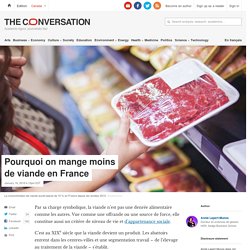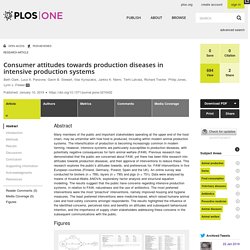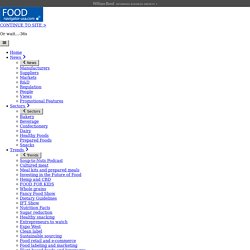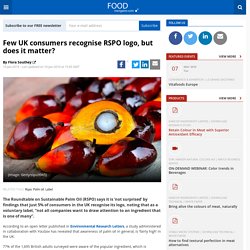

Protein mania: the rich world’s new diet obsession. Bienvenue dans l’ère de la consommation spirituelle. Quel est le point commun entre la tendance du « retreat », l’expérience « Light my prayer » ou encore l’application « La Quête » ?

Il s’agirait du dessein des « millennials » qui s’essaient à la redéfinition des contours de la consommation en Occident. Pourquoi on mange moins de viande en France. Par sa charge symbolique, la viande n’est pas une denrée alimentaire comme les autres.

Vue comme une offrande ou une source de force, elle constitue aussi un critère de niveau de vie et d’appartenance sociale. L’image des compléments alimentaires progresse. Dans le cadre de l’Observatoire annuel du Synadiet, le syndicat national des compléments alimentaires, OpinionWay a interrogé les Français sur leurs perceptions et leurs habitudes de consommation des compléments alimentaires.

Ils reconnaissent à 93 % leurs bénéfices pour la santé. Ils constatent notamment leurs bienfaits à certaines périodes de la vie comme la croissance ou le vieillissement (+ 7 points par rapport à 2018), à certaines périodes de l’année pour éviter et limiter les petits maux (+ 8 points), pour prévenir ou ralentir certains problèmes de santé (+ 13 points) et pour limiter les déficiences alimentaires (+ 9 points). Les Français sont 46 % à avoir déjà consommé des compléments alimentaires. 61 % des jeunes changent de marques en raison des emballages / Emballage. Consumer attitudes towards production diseases in intensive production systems. Abstract Many members of the public and important stakeholders operating at the upper end of the food chain, may be unfamiliar with how food is produced, including within modern animal production systems.

The intensification of production is becoming increasingly common in modern farming. However, intensive systems are particularly susceptible to production diseases, with potentially negative consequences for farm animal welfare (FAW). Previous research has demonstrated that the public are concerned about FAW, yet there has been little research into attitudes towards production diseases, and their approval of interventions to reduce these.
This research explores the public’s attitudes towards, and preferences for, FAW interventions in five European countries (Finland, Germany, Poland, Spain and the UK). Les vins du Québec : les consommateurs en redemandent ! Le marché végétarien et végan en hausse de 24% dans les grandes surfaces en 2018 - Infos Reuters. C'est un montant comparable à celui du sans gluten, mais dix fois inférieur aux ventes de produits bio.

Les ventes de produits végétariens et végans ont généré l'an dernier un chiffre d'affaires en hausse de 24%, à 380 millions d'euros, dans les grandes et moyennes surfaces (GMS) françaises, selon des données publiées le 8 janvier par l'institut d'études Xerfi. Ce dernier anticipe pour la période 2019-2021 une progression annuelle moyenne de 17% du marché de l'alimentation végétarienne et végane GMS, qui dépassera ainsi les 600 millions d'euros d'ici trois ans. Porté par les scandales alimentaires "La multiplication des scandales alimentaires, la remise en cause des bienfaits supposés du lait et de la viande ou encore la sensibilité accrue au bien-être animal ont de fait poussé les Français à se détourner des produits carnés au profit des protéines végétales", note Xerfi dans un communiqué.
Alimentation : Les marchés végétarien et végan s’envolent. Viande bovine : La consommation augmente de 1,6 % en 2018. Sorry. Nouvel état des lieux sur la consommation de viande rouge. Publié le 31 décembre 2018 Deux enquêtes récentes réalisées auprès d’acheteurs et consommateurs de viande rouge font le point sur les habitudes de consommation de cette catégorie de produits en France et mettent en exergue la méconnaissance du système d’étiquetage des viandes bovines en libre-service basé sur des étoiles.

Une récente étude publiée dans la revue Viandes & Produits carnés présente les résultats de deux enquêtes réalisées auprès de 625 acheteurs et consommateurs de viande bovine. La première a été réalisée via des questionnaires en face à face, la seconde via Facebook. L’achat d’aliments ultra-transformés en supermarchés et magasins à grande surface au Québec. Au cours des dernières décennies, le recours aux aliments produits en industrie a augmenté au détriment des aliments frais.

Certains de ces aliments industriels, nommés aliments ultratransformés, sont typiquement riches en sucres, sodium ou gras saturés. European consumers' readiness to adopt insects as food. A review. Gallup Poll: Vegetarian and vegan Americans. A Gallup poll reports the percentages of vegetarians and vegans in America. 5% of Americans say they are vegetarians, unchanged from 20123% say they are vegans, little changed from 2% in 2012.

Organic: ‘An age-old growth driver that’s here to stay,’ says Nielsen. Organic products sales continue to increase year-over-year, accounting for $21bn in sales for the 52 weeks ending Nov. 24 2018, up nearly 9% in dollar sales and 8% in units compared to last year.

“Gone are the days when organic products catered to a singular or specific audience. Today, organics have hit the mainstream,” Nielsen said. “Not only are organic products boosting our industry’s top-line, they are being purchased more by all generational and age cohorts. That said, some segments of our population are leaning into organic more than others.” “At a time when the FMCG industry overall has experienced flat volume consumption, this growth is huge,” Nielsen noted. Organic purchases by age group Few UK consumers recognise RSPO logo, but does it matter? According to an open letter published in Environmental Research Letters, a study administered in collaboration with YouGov has revealed that awareness of palm oil in general, is ‘fairly high’ in the UK. 77% of the 1,695 British adults surveyed were aware of the popular ingredient, which is frequently associated with deforestation, biodiversity loss and climate change.

Just 41% of UK consumers, however, perceived palm oil to be ‘environmentally unfriendly’. YouGov's study investigated consumer reactions to six ecolabels focused on sustainable practices, including the palm oil-focused RSPO, and one fictitious ecolabel, with varying results. Leading the pack Study: What kind of impact does food labeling have on consumption? "Many old and new food policies focus on labeling, whether on food packages or restaurant menus. Remarkably, the effectiveness of these labels, whether for changing consumers' choices or industry product formulations, has not been clear," senior and corresponding author Dariush Mozaffarian, M.D., Dr.P.H., dean of the Friedman School, said. "Our findings provide new evidence on what might work, and what might not, when implementing food labeling.
" Across all studies, the average intervention duration was 69.8 weeks (range: 3 days to 9 years), except for laboratory studies, which were typically conducted over one to three sessions. In 14 studies, food labeling was combined with other components such as education, mass media campaigns, economic incentives, or direct regulation (restrictions, bans, requirements of the contents or availability of certain nutrients or food/beverage items).
Consumers want internationally-inspired flavors, but also nostalgic options, Kerry predicts. “There is a unique balance between nostalgic taste and avant-garde experiences that consumers seek today,” according to Kerry, which recently released its 2019 Taste Charts that track sales performance, consumer trends, foodservice influences and internal expertise to predict emerging and maturing flavor trends for upcoming year. Based on its analysis it predicts that Americans will continue to seek out “authentic and unconventional taste experiences,” across categories. For example, it notes that ube, or the purple yam traditionally used in the Philippines, will continue to gain traction in sweets in the US in 2019. Similarly, horchata, which hails from Mexico and Spain, and Chai from India will become more popular in sweets, Kerry predicts.
‘Consumers have been mislead’: BEUC insists nutrient profiles 10 years overdue. According to the BEUC, it is common for foods and drinks “loaded with sugar, salt or fat” to carry nutrition claims such as “high in fibre” or “B vitamins”. 48% of consumers buy dairy- and plant-based milks, reveals IPSOS survey. In the survey, conducted as the dispute over labeling conventions in the category heats up, 48% said they had purchased both plant-based and dairy milks, 47% said they had only bought dairy milk, and 5% said they only bought plant-based milk over the period.
Click HERE to view the survey data. When looking at personal consumption, however, there was a stronger share of dairy-milk-only consumers (62%) and plant-based-only consumers (12%), with around a quarter (26%) drinking both types of milk. What is the future of vegan food? Culinary comfort and honesty on health. The latest Mintel Global New Products Database revealed that, in 2018, the UK was the country with the highest number of new vegan products launched, overtaking Germany which had previously led the vegan charge.
This reflects an acceleration of vegan innovation in the UK. Mintel revealed that 16% of new products launched in 2018 had a vegan or no animal ingredients claim. This is up from just 8% in 2015. Growth in the UK has been propelled by an increase in the number of consumers looking for animal-free options, which are viewed as more ethical and healthier. US consumers continue to eat more natural and processed cheeses. According to USDA data, Americans drank 149 lbs of milk per capita in 2017, down from 247 lbs in 1975. Conversely, during the same 42-year time period, per capita cheese consumption has more than doubled from 14.3 lbs in 1975 to 36.9 lbs in 2017.
Underscoring the decline of US milk consumption, Rabobank pointed out that it takes about 10 lbs of milk to produce one lb of cheese. "As a result, the 98-pound annual decrease in fluid milk consumption has been more than offset by the 226-pound increase in milk used to manufacture cheese," noted Rabobank global strategist, Mary Ledman, and Tom Bailey Rabobank senior analyst, dairy, in a report. Mintel: Half of Canadian consumers are snacking more often turning to fresh, less processed items.
As many Canadian consumers are switching up their daily eating patterns opting for a series of better-for-you snacks, there is an opportunity for manufacturers and retailers to meet this demand with more on-the-go snacking items, says Mintel. 65% of snackers surveyed (out of 1,959 internet users aged 18 and over) believe it is important to have healthy snacks within an arm's reach at all times. Anything can be a snack Keeping up with this consumer interest in all-day healthy snacking doesn't require an entirely new game plan, according to Carol Wong-Li, associate director, lifestyles and leisure reports, at Mintel.
Millennials buy more wine online and want it to be organic. Across food and beverage, consumers are demanding transparent supply chains. They want to know what goes into products before they purchase and consume them, and have made a push for more organic and sustainable choices. Paying the price for animal welfare. What’s the new research? The Business Benchmark on Farm Animal Welfare (BBFAW) assessed 150 food companies in 23 countries, including 63 manufacturers and producers, as well as retailers, wholesalers, restaurants and bars. Firms were assessed on their approach to managing farm animal welfare in four areas: management commitment and policy, governance and policy implementation, leadership and innovation, and performance reporting and impact. This year, the scores were more heavily weighted towards reporting and impact – for example, the proportion of animals in their supply chain that are free from confinement and pre-slaughter stunned, and whether animals arrive within specified maximum journey times.
So, how did manufacturers do? The downside of exclusion diets: From paying more to dampened social life. Spoon Guru, an AI-powered food search and discovery platform, collected data from 2,000 US adults who follow a lifestyle diet or have a food intolerance or allergy. The data revealed consumer struggles when it came to food shopping in particular with respondents reporting confusion when grocery shopping due to poor or non-existent food labeling.
Survey: 53% of consumers motivated to purchase by 'natural' claim. Dive Brief: Ethical consumption as a high-status practice. The study classified shoppers as “ethical” eaters, “foodies” (driven by taste and aesthetics), both or none. Vegetarians, omnivores more willing than vegans to eat insects. Observatoire des prix de grande consommation 2018. Consommation durable : l’engagement de façade des classes supérieures. Deuxième édition de l'Eurobaromètre sur les habitudes de consommation de produits de la pêche et de l'aquaculture. EU consumer habits regarding fishery and aquaculture products. Bag in Box en Europe du Nord - Business France. Nutrition quality of food purchases varies by household income: the SHoPPER study. Consumer perception of original and modernised traditional foods of Indonesia. Social, temporal and situational influences on meat consumption in the UK population.
Aux Etats-Unis, un double étiquetage de date satisfait le consommateur. Agroalimentaire et pouvoir d’achat : 29% de sondés pensent réduire leurs dépenses alimentaires. Lancement d’un Observatoire du Véganisme. Évolution des attentes et des tendances de consommation des produits labellisés « agriculture biologique » en France.
Baromètre de consommation et de perception des produits biologiques en France 2019. Kids' fast food consumption is up despite restaurant nutrition pledges, one study reports. Packaged Facts: The clean label consumer profile. Ce que pensent les Français de la qualité des produits. Habitudes alimentaires et consommations hors domicile des Américains. America’s Eating Habits: Food Away From Home. Both At Home and Away, Americans Are Choosing More Lower Fat Foods Than They Did 35 Years Ago. Food Spending of Middle-Income Households Hardest Hit by the Great Recession.
Protein: Consumers Want It, But Don't Understand It. The Evolution of the Sustainability Mindset. Consumers underestimate the emissions associated with food but are aided by labels. Les Français n'échappent pas à l'engouement mondial pour le café. La pêche durable, nouvel enjeu, mais pas la priorité des consommateurs. L’impact du véganisme sur le comportement des consommateurs. Paris, première ville consommatrice de vins dans le monde.
L’homme qui consomme. Consommation : Les protéines végétales jugées bonnes pour la santé. What is local food? The case of consumer preferences for local food labeling of tomatoes in Germany. Could animal welfare claims and nutritional information boost the demand for organic meat? Evidence from non-hypothetical experimental auctions. Packaged Facts: The clean label consumer profile. Kids' fast food consumption is up despite restaurant nutrition pledges, one study reports. Cargill: Americans are eating more fish than they did five years ago, prioritizing nutrition and sustainability. Teen trends: A ‘real desire’ to know more about how food is produced. ‘Local brands are winning hearts and minds’: Rising demand for local food in Europe. Bottled water dominates 2018; sparkling and value-added options surge. Healthier, tastier and safe – but will consumers accept microwave drying?
Health and gluten-free products top products of the year. Survey: Half of US consumers buy both dairy and plant-based milk. Clean labels are more important than brand, study finds. Only 3 in 10 US consumers would buy cultured meat, study finds. “I Feel Sorry for Them”: Australian Meat Consumers’ Perceptions about Sheep and Beef Cattle Transportation. SIAL 2018 : Les consommateurs ont soif de transparence en Europe. Boissons alcoolisées : La diminution de la consommation des ménages français se poursuit. Consommer mieux et moins : la tendance à la frugalité ? Les Millennials deviennent les plus gros consommateurs de produits de la mer. Five Decades of Price Swings for Food and Other Consumer Spending Categories. Vogue du vegan en Allemagne : adieu la « currywurst » ? Consommation de viande, santé humaine et environnement. Meat consumption, health, and the environment.
The rise of no and low alcohol. Perishables Are Keeping Pace with Evolving Consumer Needs Across the Grocery Store. 72% des e-acheteurs intéressés par la livraison dans le domicile. Les fruits piliers de notre quotidien : mythe ou réalité ? Consumer Movements and Collective Creativity: The Case of Restaurant Day. How to improve consumers' environmental sustainability judgements of foods. Survey: Nearly Half of U.S. Consumers Avoid GMO Foods; Large Majority Primarily Concerned About Human Health Impact - IFIC Foundation - Your Nutrition and Food Safety Resource. Image de la viande de lapin 2018. The impact of organic certification and country of origin on consumer food choice in developed and emerging economies. Consumers are equating ‘clean’ with ‘healthy’, Mintel finds. Projected 8.2% growth of mushroom market through 2024 attributed to interest in food as medicine.
Sugar replaces price as consumers’ top food worry. What are children drinking? CDC data exposes sharp differences according to ethnicity. Is there a protein perception problem? Nielsen surveys reveal consumer knowledge gaps. Vegan products growing exponentially, with Germany leading the way. Going clear: Transparent beer, coffee and soda are trending in Japan. Report: Consumers want increased transparency from retailers and brands. Ready Meals Briefing final. Fruits and vegetables at home (FLAM): a randomized controlled trial of the impact of fruits and vegetables vouchers in children from low-income families in an urban district of France.